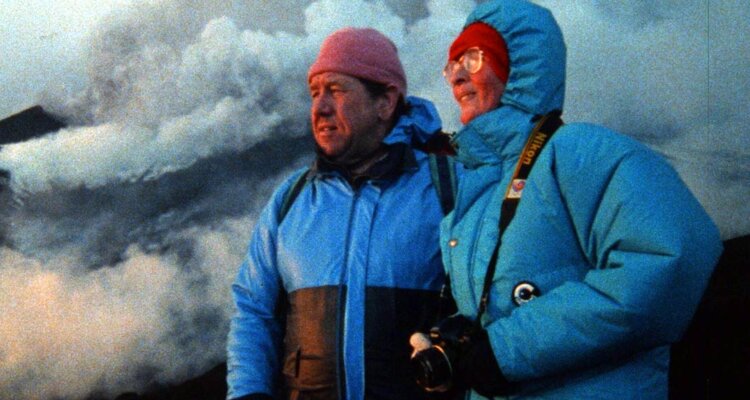“Curiosity is stronger than fear,” utters Katia Krafft, via an actress giving voice to her writing, underscoring images of unimaginably scorching lava exploding around her. With her endearingly reckless husband Maurice Krafft, they form the one-of-kind couple that blazes through the arresting documentary “Fire of Love” from director Sara Dosa.
READ MORE: Sundance 2022 Preview: 20 Must-See Movies From The Festival
Constructed from the hundreds of hours of grainy footage that the intrepid French volcanologists, previously featured in Werner Herzog’s own exploration on the subject “Into the Inferno,” left behind after their untimely passing, the film makes the case that their marriage was the foundation of their fearlessness. Together they can stare into the abyss and face near-death experiences for the sake of discovery, of seeing the yet unseen.
Dosa enlists writer-director Miranda July to narrate. This narrative device allows the filmmaker to influence the material beyond its purposive assemblage. The soft-spoken prose fills in the blanks with context and poetic interpretations of their work. Sporadically, short animated passages executed in silhouettes by Lucy Munger enliven these observations.
Infatuated with the terrifying grandeur of volcanic activity, the pair walked together along rivers of molten rock for over two decades, chasing the next eruption around the world. Accounts on how they first met differ (a blind date seems plausible), but what’s an indisputable fact is the cosmic clash of their encounter. To have found each other in the same town with the same peculiar interest seems like fate operating in the world’s favor.
Explosions of lava, like fireworks bursting into the sky, prove hypnotic from afar and a deadly aspect of the Kraffts’ dedication to understanding how the earth breathes and shifts. Considering that in the 70s and 80s, when the two were active, filmmaking technologies were far more rudimentary. Thus, the prospects of bodily harm based on their proximity to these natural cauldrons were high.
To witness the extent of their commitment is a reminder that for the rest of us civilians to have a chance at observing the wondrous and horrific phenomena of the planet, someone else had to capture and preserve them. Yes, there are practical reasons for this: a greater understanding of the volcanoes’ patterns to plan evacuation and save human lives, but also something indefinably profound about looking closely at the chaotic glory of the flying rock we inhabit.
Sections utilizing a split-screen provide a sense of the distinctions to Katia and Maurice’s approaches: she is a geochemist, and he is a geologist; she photographs to freeze details in time while he films the big picture in motion. A curious portion even explicates that Maurice’s deceivingly didactic footage had strong storytelling sensibilities in how he framed the shots and made sure to capture (or even stage) instances to express the arduousness of their labor and the magnitude of what they were in front of.
From hundreds of hours of adventurous film at Mount Nyiragongo in Zaire, the Nevado del Ruiz in Colombia, or Japan’s Mount Unzen, editors Erin Casper and Jocelyne Chaput strung together a singular romance burning with jaw-dropping imagery. The execution isn’t comparable to a National Geographic piece with educational intent but rather a drama with poetic expressiveness that emanates from the choreography of all the elements. Deservingly, Dosa, her two editors, and Shane Boris (also a producer) have writing credit.
It seems that the explosiveness of their field research didn’t affect their quotidian relationships. Although there’s no mention of any major schisms between them—cementing the notion that their union was enviable in its affinity—further knowledge of their day-to-day lives away from the craters or and beyond their adoration for Mount Helena or Stromboli would have been welcomed.
In between the blurred lines at the junction of their intimate bond and their intellectual partnership, what peaks through as a shared philosophical position is their disillusioned with humanity—our propensity for waging war on each other and the decision makers’ disregard for life-saving information—as well as their efforts to reconnect with people.
As much as we learn about the erratic behavior classification of these massive mounds of grunting gas, rock, and pressure (divided mainly between red and gray volcanoes, the latter being the more hazardous), the fuel of “Fire of Love” is their magma-proof adoration for each other and what they’ve laid eyes on. The Krafft’s globetrotting love story exists at its most ardent in proximity of their mutual passion. [A-]
Follow along with all our coverage of the 2022 Sundance Film Festival.

